Optimal Allocation of Water Resources from the “Wide-Mild Water Shortage” Perspective
Abstract
1. Introduction
2. Diminishing Marginal Utility in Water Resources Utilization
3. Water Resources Optimal Allocation from the Perspective of “Wide-Mild Water Shortage”
3.1. The Concept of Wide-Mild Water Shortage
3.2. Piecewise Linear Function
3.3. Methodology
4. Case Study
4.1. Study Area
4.2. Parameter Determination
5. Results and Discussion
5.1. Water Supply and Shortage
5.2. Changes in the Units with Water Shortage
5.3. Comparison of Water Shortage and Process
5.4. Comparison of Water Shortage Range
6. Conclusions
Author Contributions
Funding
Conflicts of Interest
Appendix A
| Name | Catchment Area km2 | Flood Control Capacity Million m3 | Storage Capacity Million m3 | Dead Capacity Million m3 |
|---|---|---|---|---|
| BR1 | 66,382 | 8610 | 6456.3 | 487.5 |
| BR2 | 3745 | 995 | 740 | 310 |
| BR3 | 683 | 117 | 74 | 7 |
| BR4 | 1660 | 281 | 162 | 14 |
| BR5 | 15,112 | 260 | 177 | 23 |
| BR6 | 2241 | 298 | 49 | 5 |
| BR7 | 13,500 | 150 | 84 | 14 |
| BR8 | / | 450 | 315 | 110 |
| BR9 | 7780 | 1253 | 1067 | 34 |
| BR10 | 548 | 235 | 207 | 63.5 |
| BR11 | 342 | 51 | 40.6 | 4 |
| BR12 | 60 | 209 | 390.3 | 34.5 |
| BR13 | 35 | 110 | 107 | 10 |
| BR14 | 5300 | 405 | 405 | 105 |
| PR1 | 8250 | 1685 | 1483 | 320 |
| PR2 | 10,720 | 989 | 859 | 242 |
| PR3 | 24,384 | / | 350 | 50 |
| PR4 | 32,229 | 3331 | 3507 | 1007 |
| PR5 | 19,487 | 3113 | 2554 | 556 |
| PR6 | 16,137 | 3508 | 2926 | 248 |
| PR7 | 1990 | 187 | 143 | 32 |
| PR8 | 2050 | 754 | 754 | 95 |
| PR9 | 2072 | 307 | 132 | 45 |
| PR10 | 438 | 70 | 31 | 1 |
| PR11 | 853 | 96 | 43.64 | 6.33 |
| PR12 | 1773.6 | 240 | 220 | 104 |
| PR13 | 2444 | 450 | 380 | 132 |
| PR14 | 8200 | 3100 | 3100 | 1455 |
| PR15 | 12,426 | 1640 | 1486 | 198 |
| PR16 | 1790 | 538.2 | 352 | 19.4 |
| PR17 | 4206 | 76 | 45 | 8 |
| PR18 | 7610 | 574 | 498 | 31 |
| PR19 | 9050 | 360 | 132 | 86 |
| Water Resource Zone | Catchment Area km2 | Water Use (in 2013) Billion m3 | Sub Units |
|---|---|---|---|
| NEJ | 67,775 | 0.36 | GGHRUP/GH/GGHR TONEJR |
| JQ | 99,678 | 4.82 | NMH/NMEH/NER TOTH/ALH/YH/YLH/TH TO JQ |
| BST | 131,049 | 7.43 | CEH/THE/HLH/JQ TO BST/BST TO SHJ/WYESYH/AZXH/ZLXH |

References
- Cai, X.; McKenney, D.C.; Lasdon, L.S.; Watkins, D. Solving large nonconvex water resources management models using generalized benders decomposition. Oper. Res. 2001, 49, 235–245. [Google Scholar] [CrossRef]
- Bradley, S.; Hax, A.; Magnanti, T. Applied Mathematical Programming; Addison Wesley: Boston, MA, USA, 1977. [Google Scholar]
- Singh, A. An overview of the optimization modelling applications. J. Hydrol. 2012, 466–467, 167–182. [Google Scholar] [CrossRef]
- Powell, W.B. Approximate Dynamic Programming: Solving the Curses of Dimensionality; Wiley & Sons: Hoboken, NJ, USA, 2011. [Google Scholar]
- Luenberger, D.G.; Ye, Y.Y. Linear and Nonlinear Programming, 3rd ed.; Springer: Berlin, Germany, 2008. [Google Scholar]
- Li, M.; Fu, Q.; Singh, V.P.; Ma, M.; Liu, X. An intuitionistic fuzzy multi-objective non-linear programming model for sustainable irrigation water allocation under the combination of dry and wet conditions. J. Hydrol. 2017, 555, 80–94. [Google Scholar] [CrossRef]
- Lu, H.W.; Huang, G.H.; He, L. Development of an interval-valued fuzzy linear-programming method based on infinite α-cuts for water resources management. Environ. Model. Softw. 2010, 25, 354–361. [Google Scholar] [CrossRef]
- Fu, Y.; Li, M.; Guo, P. Optimal allocation of water resources model for different growth stages of crops under uncertainty. J. Irrig. Drain. Eng. 2014, 140, 1272–1273. [Google Scholar] [CrossRef]
- Li, M.; Guo, P.; Zhang, L.; Zhao, J. Multi-dimensional critical regulation control modes and water optimal allocation for irrigation system in the middle reaches of Heihe River basin, China. Ecol. Eng. 2015, 76, 166–177. [Google Scholar] [CrossRef]
- Yang, L.; Liu, S.; Tsoka, S.; Papageorgiou, L.G. Mathematical programming for piecewise linear regression analysis. Exp. Syst. Appl. 2016, 44, 156–167. [Google Scholar] [CrossRef]
- Zhang, C.L.; Guo, P. A generalized fuzzy credibility-constrained linear fractional programming approach for optimal irrigation water allocation under uncertainty. J. Hydrol. 2017, 553, 735–749. [Google Scholar] [CrossRef]
- Hong, X.D.; Liao, Z.W.; Jiang, B.B.; Wang, J.D.; Yang, Y.R. Targeting of heat integrated water allocation networks by one-step MILP formulation. Appl. Energy 2017, 197, 254–269. [Google Scholar] [CrossRef]
- Bettinger, P.; Boston, K.; Siry, J.P.; Grebner, D.L. Forest Management and Planning Chapter 7—Linear-Programming; Academic Press: Cambridge, MA, USA, 2017; pp. 153–176. [Google Scholar]
- Eiger, G.; Shamir, U.; Ben-Tal, A. Optimal design of water distribution networks. Water Resour. Res. 1994, 30, 2637–2646. [Google Scholar] [CrossRef]
- Li, D.; Haimes, Y.Y. Optimal maintenance-related decision making for deteriorating water distribution system 2: Multilevel decomposition approach. Water Resour. Res. 1991, 28, 1063–1070. [Google Scholar] [CrossRef]
- Das, B.; Singh, A.; Panda, S.N.; Yasuda, H. Optimal land and water resources allocation policies for sustainable irrigated agriculture. Land Use Policy 2015, 42, 527–537. [Google Scholar] [CrossRef]
- Gonelas, K.; Kanakoudis, V. Reaching Economic Leakage Level through Pressure Management. Water Sci. Technol. Water Supply 2016, 16, 756–765. [Google Scholar] [CrossRef]
- Mirchi, A.; Watkins, D.W.; Engel, V.; Sukop, M.C.; Czajkowski, J.; Bhat, M.; Rehage, J.; Letson, D.; Takatsuka, Y.; Weisskoff, R. A hydro-economic model of South Florida water resources system. Sci. Total Environ. 2018, 628–629, 1531–1541. [Google Scholar] [CrossRef] [PubMed]
- Li, M.; Fu, Q.; Singh, V.P.; Liu, D. An interval multi-objective programming model for irrigation water allocation under uncertainty. Agric. Water Manag. 2018, 196, 24–36. [Google Scholar] [CrossRef]
- Bellmanr, E.; Zaden, L.A. Decision making in fuzzy environment. Manag. Sci. 1970, 17, 141–164. [Google Scholar] [CrossRef]
- Graveline, N. Economic calibrated models for water allocation in agricultural production: A review. Environ. Model. Softw. 2016, 81, 12–25. [Google Scholar] [CrossRef]
- Iftekhar, M.S.; Fogarty, J. Impact of water allocation strategies to manage groundwater resources in Western Australia: Equity and efficiency considerations. J. Hydrol. 2017, 548, 145–156. [Google Scholar] [CrossRef]
- Goetz, R.U.; Martínez, Y.; Xabadia, À. Efficiency and acceptance of new water allocation rules—The case of an agricultural water users association. Sci. Total Environ. 2017, 601–602, 614–625. [Google Scholar] [CrossRef] [PubMed]
- Berhe, F.T.; Melesse, A.M.; Hailu, D.; Sileshi, Y. MODSIM-based water allocation modeling of Awash River Basin, Ethiopia. Catena 2013, 109, 118–128. [Google Scholar] [CrossRef]
- Hassan-Esfahani, L.; Torres-Rua, A.; McKee, M. Assessment of optimal irrigation water allocation for pressurized irrigation system using water balance approach, learning machines, and remotely sensed data. Agric. Water Manag. 2015, 153, 42–50. [Google Scholar] [CrossRef]
- Roozbahani, R.; Schreider, S.; Abbasi, B. Optimal water allocation through a multi-objective compromise between environmental, social, and economic preferences. Environ. Model. Softw. 2015, 64, 18–30. [Google Scholar] [CrossRef]
- Abdulbaki, D.; Al-Hindi, M.; Yassine, A.; Abou Najm, M. An optimization model for the allocation of water resources. J. Clean. Prod. 2017, 164, 994–1006. [Google Scholar] [CrossRef]
- Brown, T.C. Water for wilderness areas: Instream flow needs, protection, and economic value. Rivers 1991, 2, 311–325. [Google Scholar]
- Brown, M.T.; McClanahan, T.R. EMergy analysis perspectives of Thailand and Mekong River dam proposals. Ecol. Model. 1996, 91, 105–130. [Google Scholar] [CrossRef]
- Turgeon, A. A Decomposition Method for the Long-Term Scheduling. Water Resour. Res. 1981, 17, 1565–1570. [Google Scholar]
- Yu, Z.L. Water Use Marginal Effectiveness Calculation Liaoning; Liaoning Normal University: Dalian, China, 2010; pp. 23–24. [Google Scholar]
- Olmstead, S.M.; Hanemann, W.M.; Stavins, R.N. Water demand under alternative price structures. J. Environ. Econ. Manag. 2007, 54, 181–198. [Google Scholar] [CrossRef]
- Ashoori, N.; Dzombak, D.A.; Small, M.J. Identifying Water Price and Population Criteria for Meeting Future Urban Water Demand Targets. J. Hydrol. 2017, 555, 547–556. [Google Scholar] [CrossRef]
- Wei, C.J.; Wang, H. Generalization of regional water resources deployment network chart. J. Hydraul. Eng. 2007, 38, 1103–1108. [Google Scholar] [CrossRef]
- Bijl, D.L.; Bogaart, P.W.; Kram, T.; de Vries, B.J.; van Vuuren, D.P. Long-term water demand for electricity, industry and households. Environ. Sci. Policy 2016, 55, 75–86. [Google Scholar] [CrossRef]

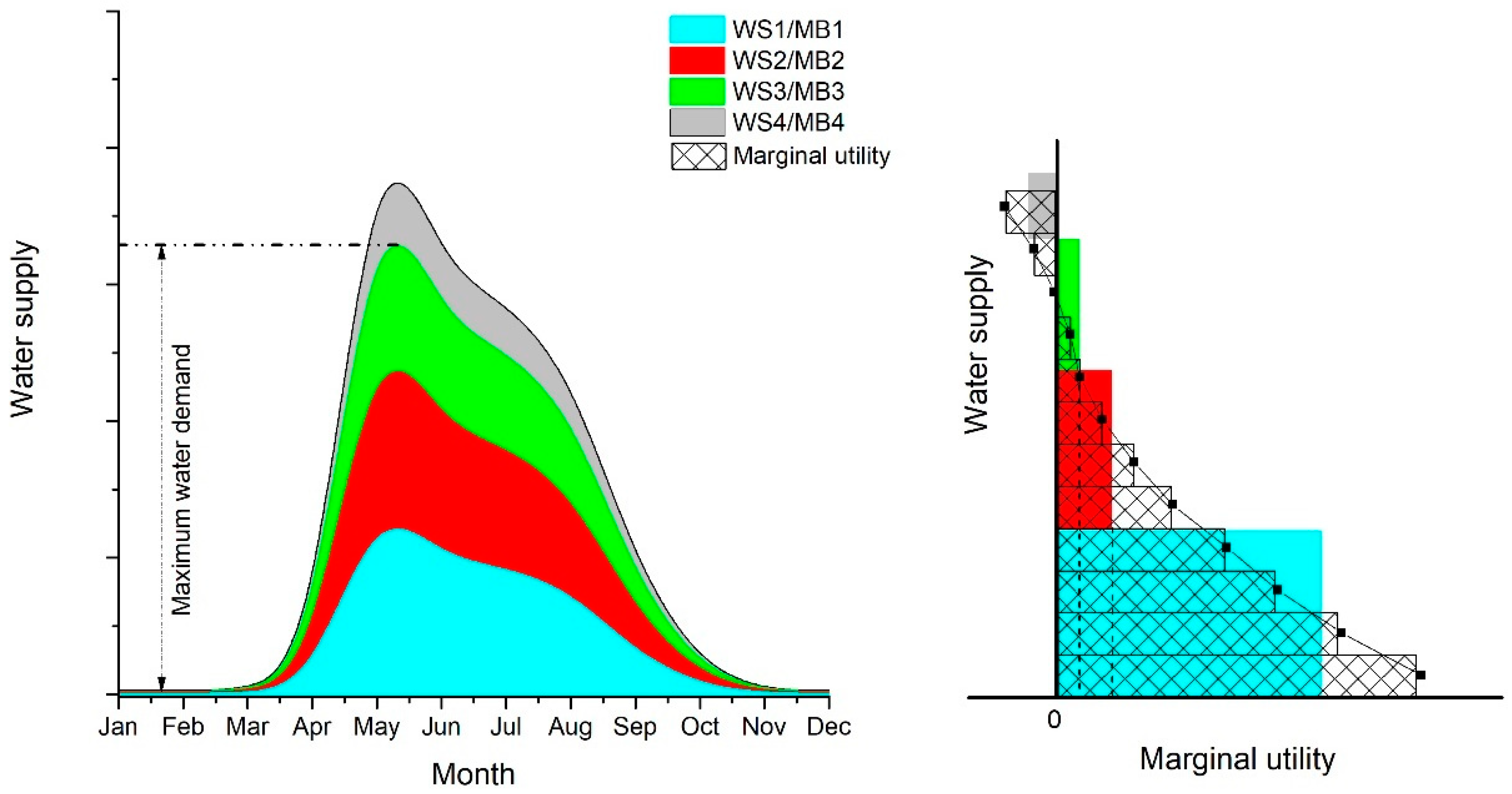
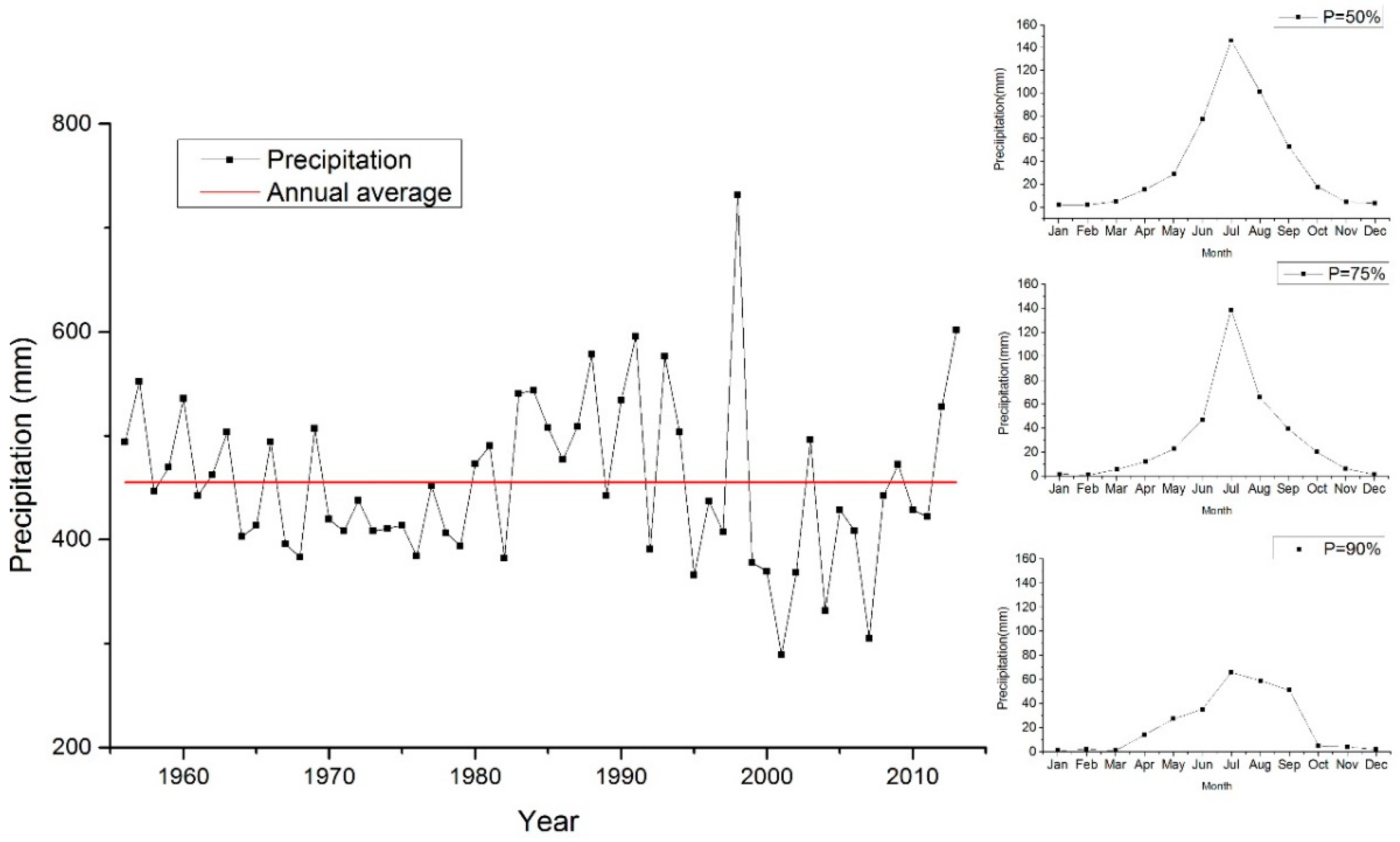

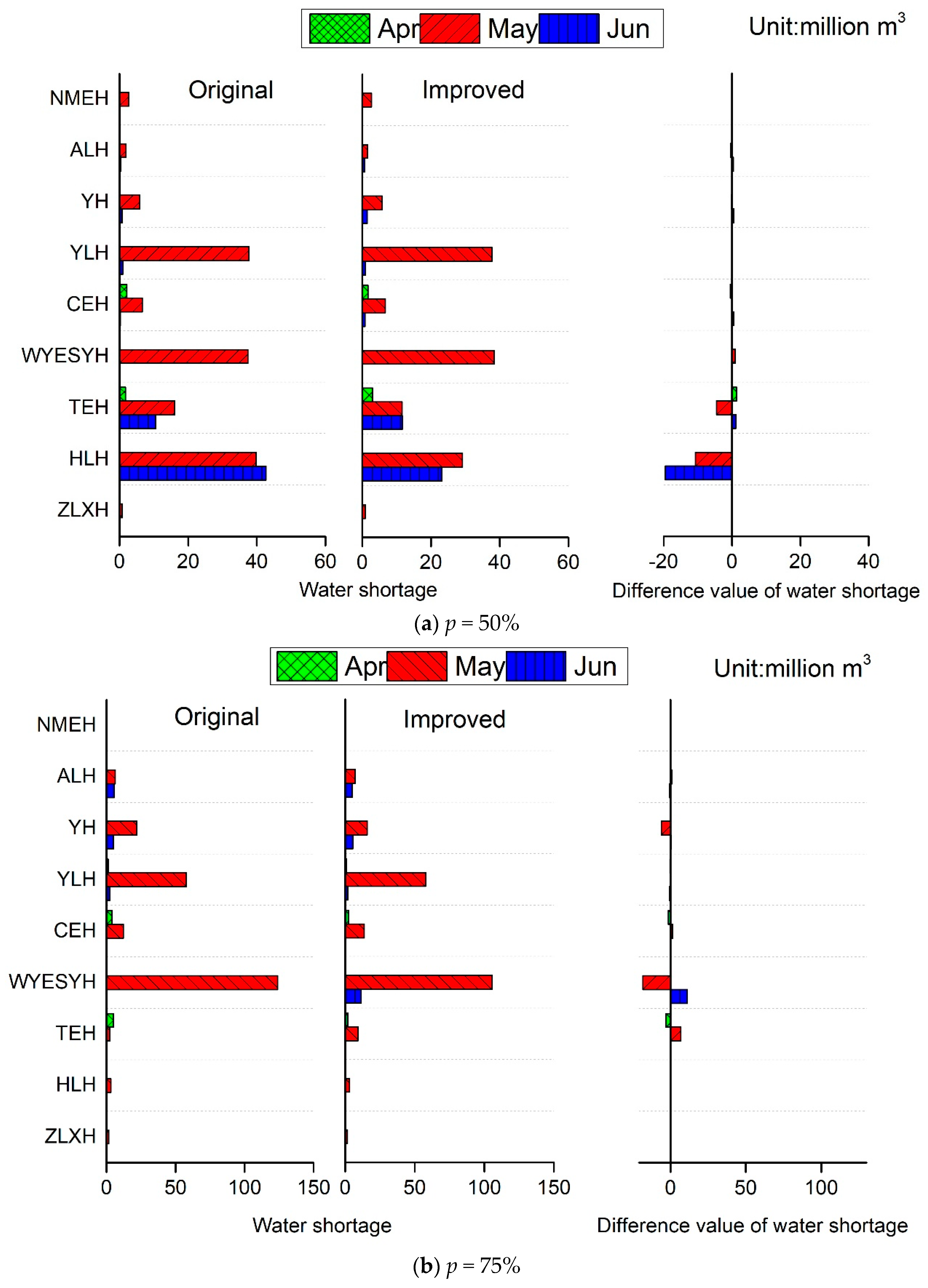
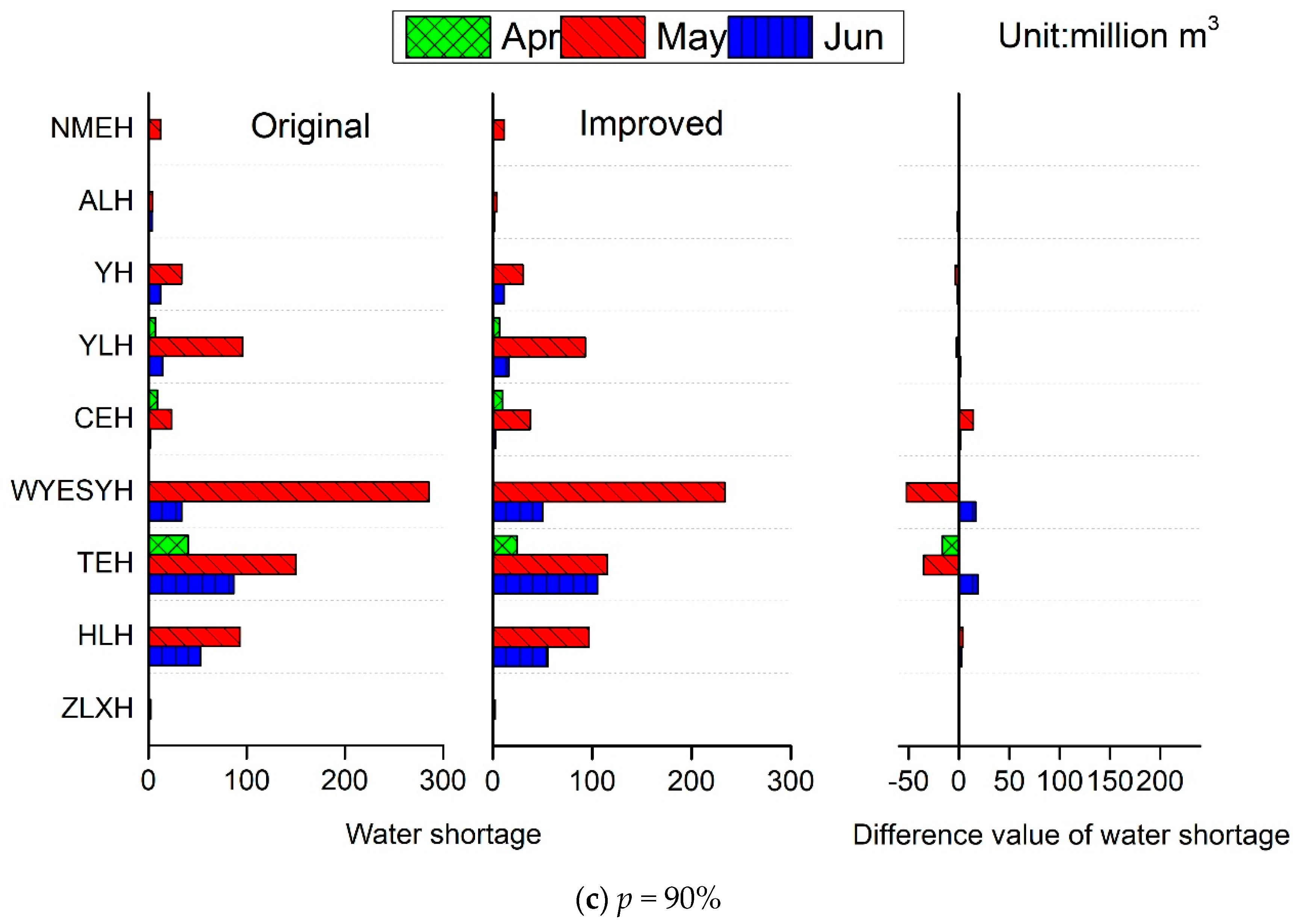

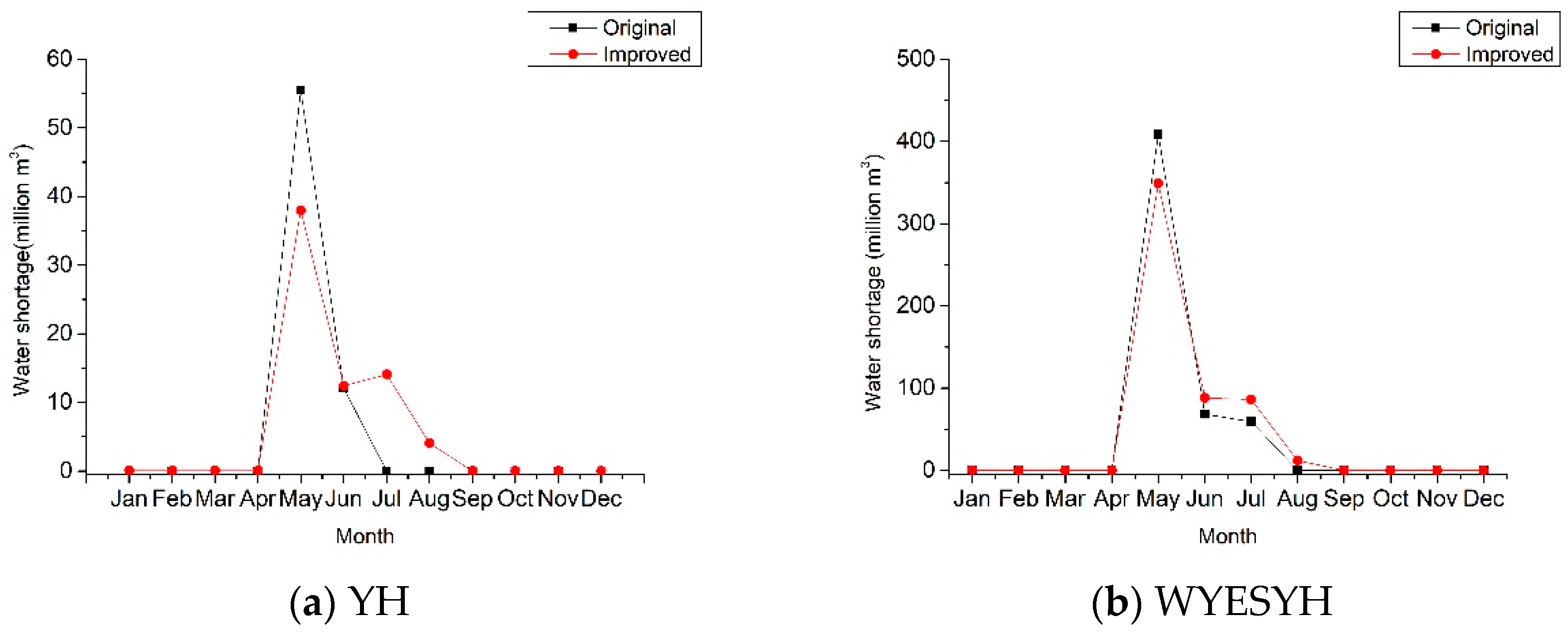
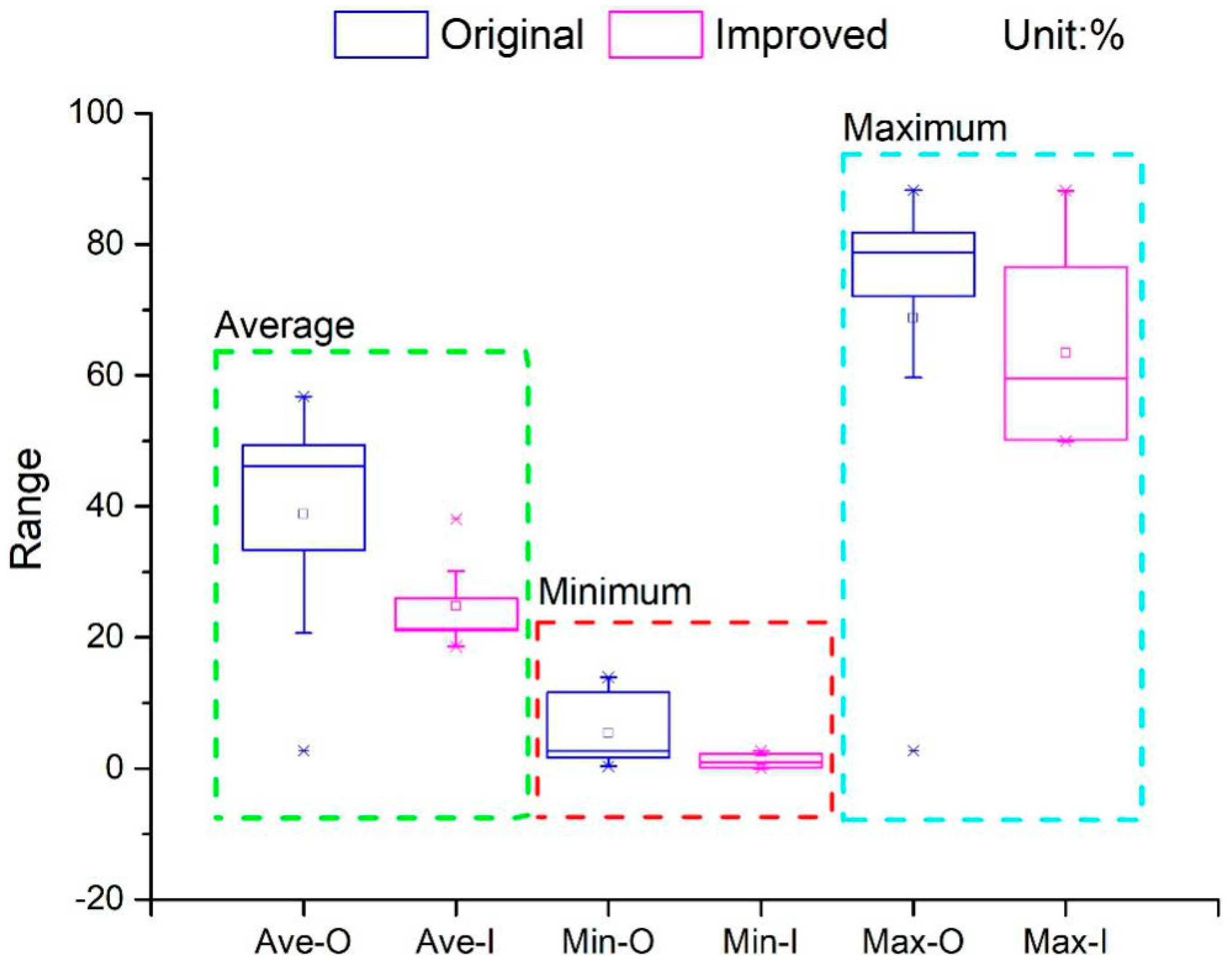


| Precipitation Frequency | Model | Numerator * | Denominator # | Ratio (%) |
|---|---|---|---|---|
| p = 50% | Before improvement | 492 | 74448 | 0.66 |
| After improvement | 853 | 1.15 | ||
| p = 75% | Before improvement | 205 | 29328 | 0.70 |
| After improvement | 285 | 0.97 | ||
| p = 90% | Before improvement | 90 | 27072 | 0.33 |
| After improvement | 192 | 0.71 | ||
| Total | Before improvement | 787 | 130848 | 0.60 |
| After improvement | 1330 | 1.02 |
© 2018 by the authors. Licensee MDPI, Basel, Switzerland. This article is an open access article distributed under the terms and conditions of the Creative Commons Attribution (CC BY) license (http://creativecommons.org/licenses/by/4.0/).
Share and Cite
He, H.; Yin, M.; Chen, A.; Liu, J.; Xie, X.; Yang, Z. Optimal Allocation of Water Resources from the “Wide-Mild Water Shortage” Perspective. Water 2018, 10, 1289. https://doi.org/10.3390/w10101289
He H, Yin M, Chen A, Liu J, Xie X, Yang Z. Optimal Allocation of Water Resources from the “Wide-Mild Water Shortage” Perspective. Water. 2018; 10(10):1289. https://doi.org/10.3390/w10101289
Chicago/Turabian StyleHe, Huaxiang, Mingwan Yin, Aiqi Chen, Junqiu Liu, Xinmin Xie, and Zhaohui Yang. 2018. "Optimal Allocation of Water Resources from the “Wide-Mild Water Shortage” Perspective" Water 10, no. 10: 1289. https://doi.org/10.3390/w10101289
APA StyleHe, H., Yin, M., Chen, A., Liu, J., Xie, X., & Yang, Z. (2018). Optimal Allocation of Water Resources from the “Wide-Mild Water Shortage” Perspective. Water, 10(10), 1289. https://doi.org/10.3390/w10101289






